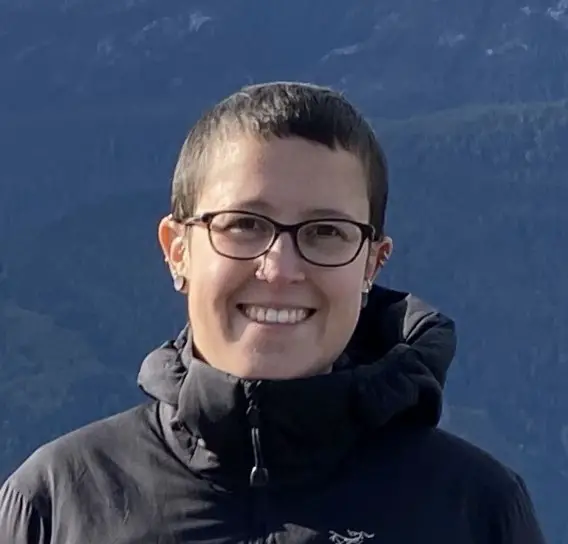Southern Vancouver Island is famous for its dramatic coastal landscapes, variety of outdoor activities, and ample wildlife-watching opportunities.
If you’re looking to appreciate the beauty of BC, then this area should be right at the top of your bucket list.
To explore Southern Vancouver Island in its entirety, you’ll want to drive the iconic Pacific Marine Circle Route. It’s a loop route that will take you along the coastline and into the middle of the island, so you’ll get to explore a wealth of landscapes.
Planning this epic road trip route can often feel overwhelming, but don’t worry, we’re here to help! With this guide, we’ll take you through everything you need to know when it comes to the Pacific Marine Circle Route. This includes the best places to visit, where to stay, and some other top tips.
Pacific Marine Circle Route Overview
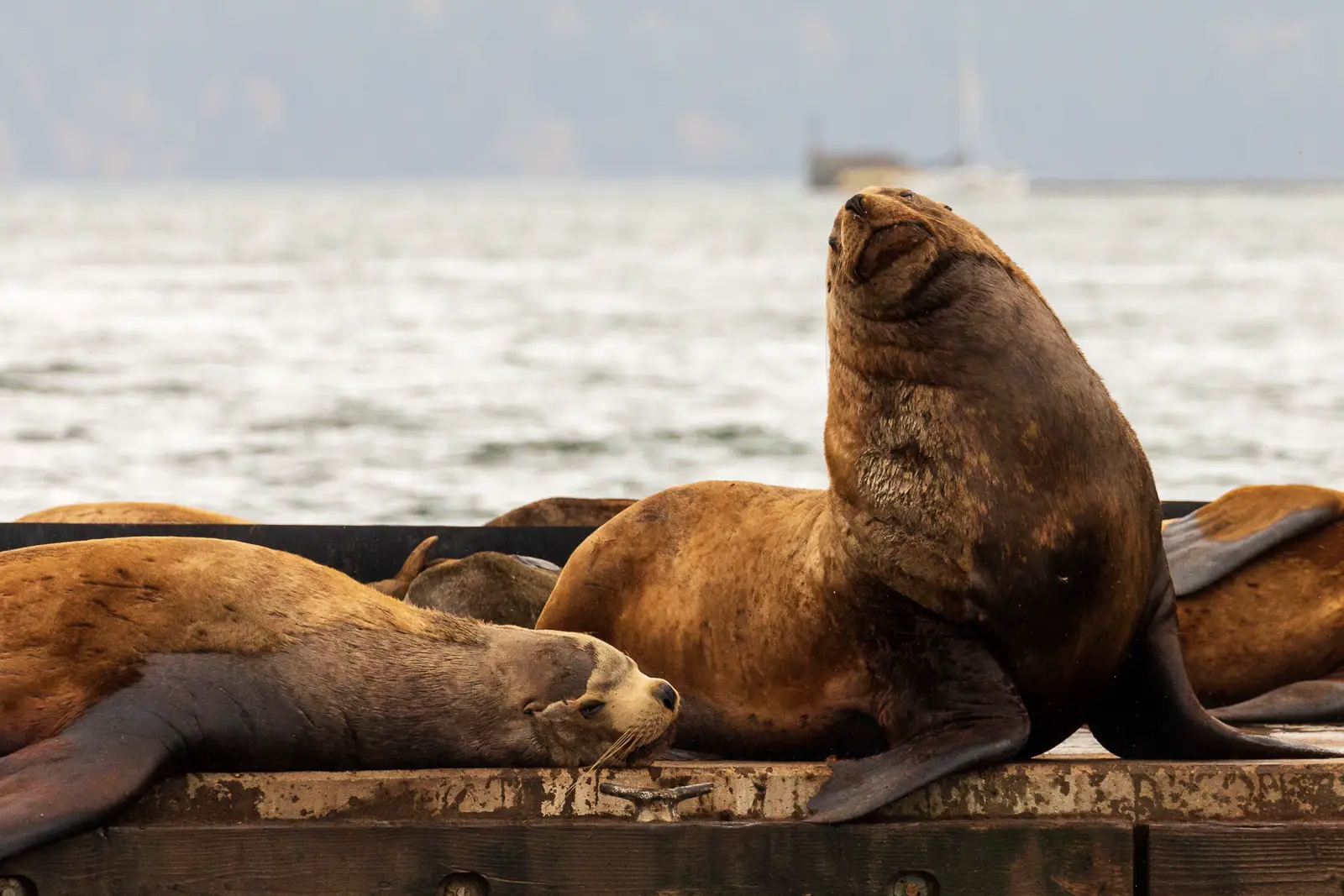
Covering a total distance of 263 km (163 miles), the Pacific Marine Circle Route takes you along the coastline and through the old-growth forests of Southern Vancouver Island.
This epic road trip starts (and ends) in Victoria, BC’s beautiful capital city, and takes you along the wild coastline past Sooke and to the towering trees of Port Renfrew.
From there, you’ll loop back inland to explore the stunning lakes and wineries of the Cowichan Valley. End your adventures by driving back along the beautiful Saanich Inlet, stopping to see spectacular waterfalls, sea lions, and spawning salmon.
With unparalleled views along the way, this is a road trip that you won’t want to skip! It only takes about 5 hours to drive the entire loop, but you’ll want at least two to three days to fully explore everything that it has to offer.
And, while we’d recommend driving the whole route for the best experience, you can split the journey up, or pick different start/end points if you wish!
Driving Directions
The Pacific Marine Circle Route loops around Southern Vancouver Island, starting and ending in Victoria, BC. It’s about 263 km long and while it can be driven in a day (about 5 hours if you don’t stop), we highly recommend taking at least two or three days to drive it. There’s so much to see and do!
You can drive the Pacific Marine Circle Route in either direction. We prefer driving the loop clockwise, so that’s how we will present it in this article. We don’t really have a reason for why we prefer this direction though. The road trip is great in both directions!
Assuming you drive the loop clockwise, you’ll leave Victoria and adventure along Highway 14, past Juan de Fuca Provincial Park and to Port Renfrew. Once there, you’ll follow the Pacific Marine Road north to Lake Cowichan. The next leg of the journey follows the Cowichan River, taking you east along Highway 18 to Duncan. Lastly, you’ll drive south on Highway 1 (the Malahat Highway) back to Victoria.
If you’re short of time, then you can just drive a section or two of this iconic road trip. Nonetheless, you should really try to drive the whole route as it has so much to offer!
Tips for Driving the Pacific Marine Circle Route
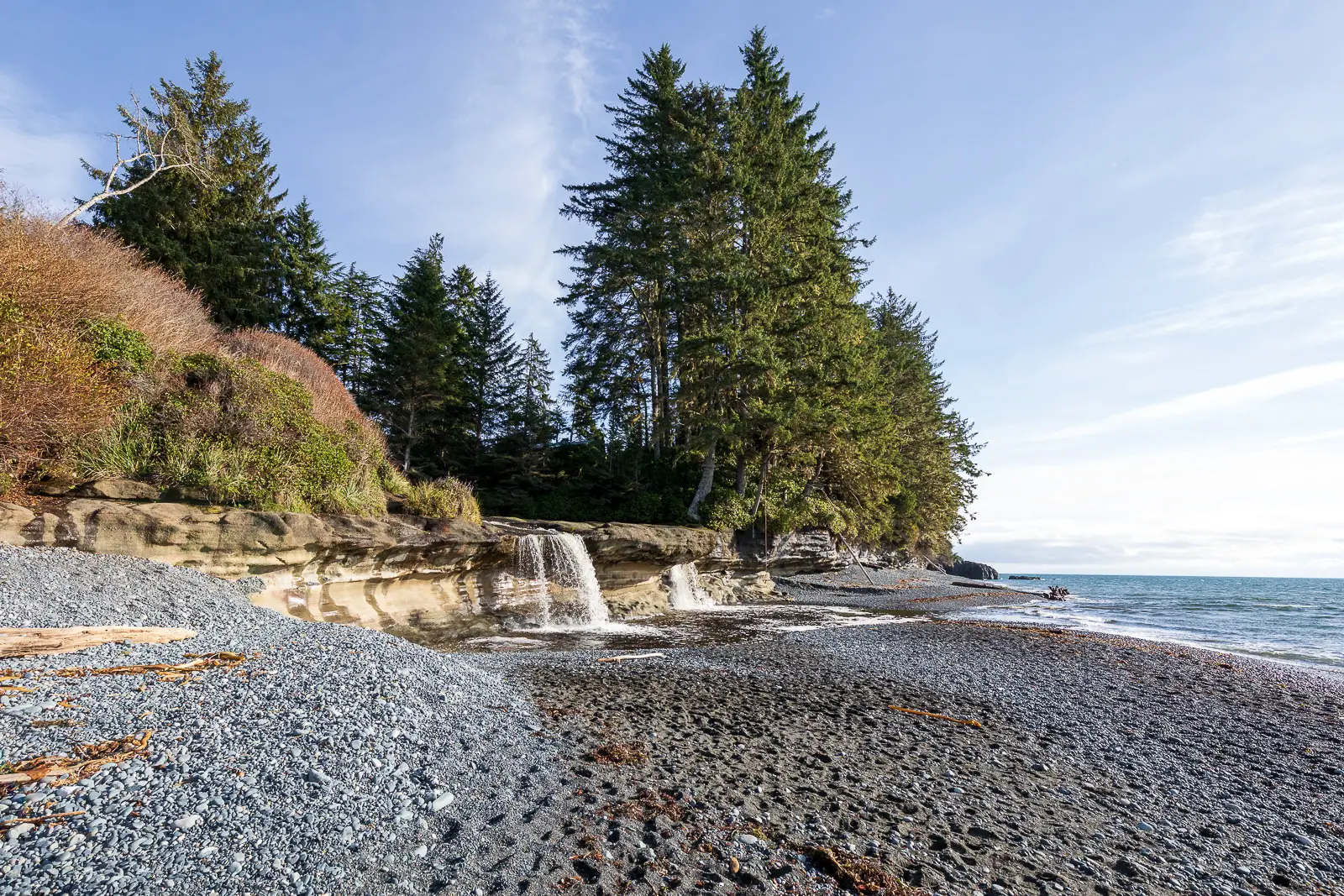
Before we dive into the best places to visit, where to stay, and all the other juicy stuff, we’ve got some top driving tips that you should know about the Pacific Marine Circle Route.
First of all, the main roads along this road trip are all paved. That being said, if you venture off the highways (which you should), expect bumpy gravel roads with potholes. Generally, you won’t need a 4WD vehicle to get to most places though (except a few of Port Renfrew’s big trees).
Keep in mind that even the main roads are relatively twisty and bumpy. Also, most of the highways have just two lanes (and some single-lane bridges). Make sure to pull over and let faster vehicles pass!
Another key thing to mention: you’ll find very limited services between Sooke and Lake Cowichan. There are no gas stations, stores, or restaurants, except for in Port Renfrew — and those aren’t always open. We recommend filling up at a gas station in Sooke or Lake Cowichan and making sure you have all the essentials beforehand!
Cell service is also very limited along parts of the Pacific Marine Circle Route. Reception is improving — a cell tower was recently built near Sooke — but you’ll still lose service at some point between Sooke and Lake Cowichan.
While the roads are well signed, bring a backroads map or download offline maps so you don’t get lost when out of service. We’d also recommend bringing a Garmin InReach for when you’re off-grid. It can be a lifesaver if there’s an emergency.
Also, you’ll likely get cell service from the US towers — make sure to turn off roaming while along the Juan de Fuca Strait so you don’t get extra charges!
Lastly, if you drive the Pacific Marine Circle Route during winter (which is just as beautiful as the summer and a great time to see the waterfalls), you’ll need winter tires to complete the trip. From October 1 to March 31, the Malahat Highway (Highway 1) and Highways 14 and 18 all require winter tires — even if there’s no snow.
How Long Is the Pacific Marine Circle Route
Technically, it’s possible to drive the whole Pacific Marine Circle Route (263 km) in one day. It will take you around 5 hours but that’s without any stops — and really, what’s the point of that? Especially when there are so many fabulous places to visit along the way!
Most of the activities in this guide will take at least a few hours. You’ll also want time to explore the towns and stop to enjoy the views or for a bite to eat!
We’d recommend taking at least 2-3 days to drive the whole route. This will give you plenty of time to enjoy the views, visit some of the area’s iconic attractions, and relax too.
Best Stops & Places to See on the Pacific Marine Circle Route
Driving the Pacific Marine Circle Route is a bucket list experience for sure! Boasting dramatic landscapes, coastal forests, and wild beaches, the beauty of this area will take your breath away.
From epic views to marine mammal sightings, there’s no shortage of things to do and see along the Pacific Marine Circle Route.
Below, we’re going to cover some of the very best places along the Pacific Marine Circle Route, so make sure they’re included in your road trip itinerary!
1. Victoria to Sooke
Starting in Victoria, you’ll head on a 40 km drive to Sooke. Without stops, the drive will take around 45 minutes — although there are a couple of fantastic places to visit along the way!
If you’re from Victoria, then you’ll likely want to jump right into the road trip. The roads are relatively winding, so take your time and enjoy the drive after you’ve left the city.
However, if you’re new to the area, then you’ll want to spend some time exploring the beautiful city of Victoria first, as there’s a lot to see! It’s the capital of British Columbia after all, so you should allow an extra day for explore here first (or at the very end of your trip).
Victoria
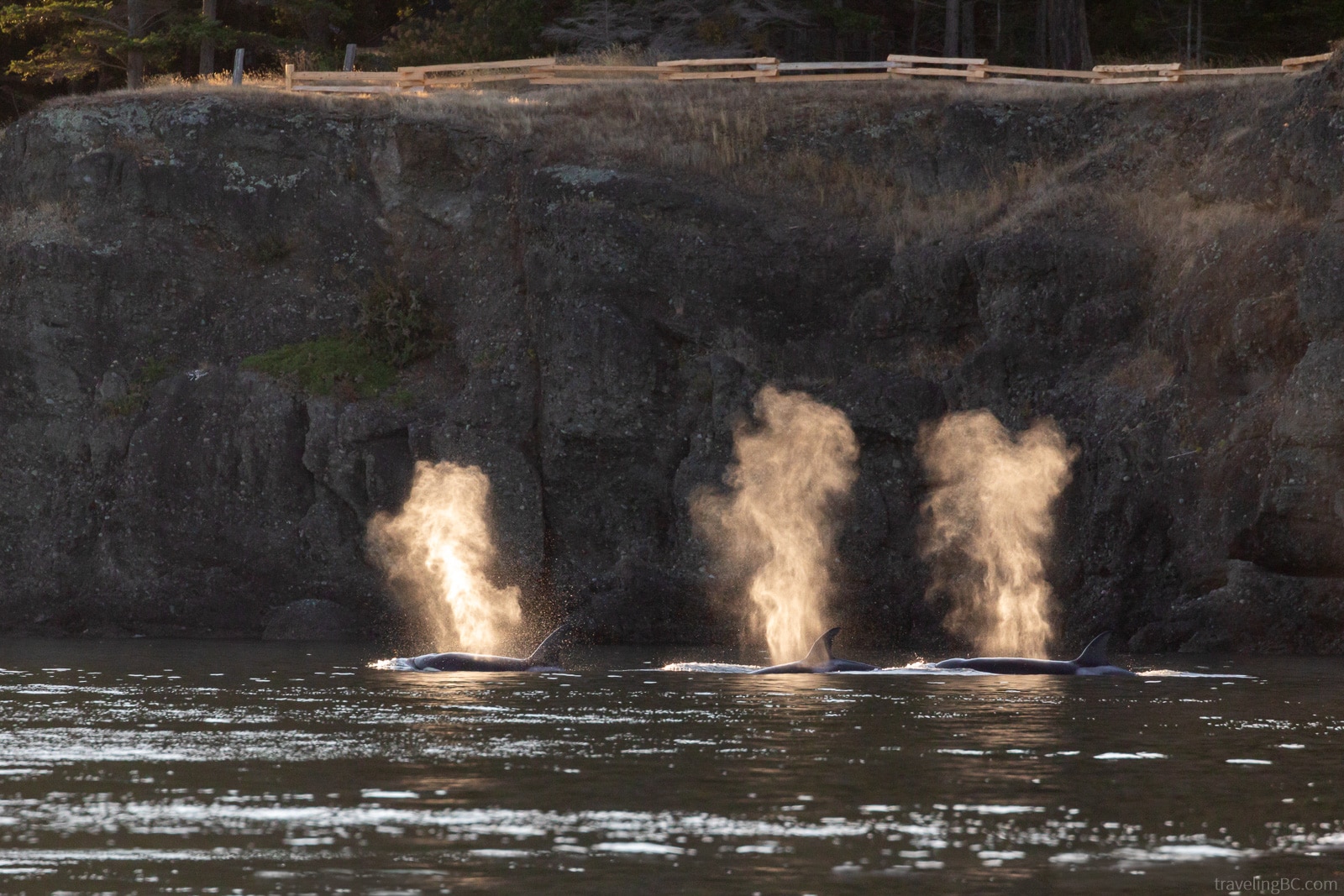
You’ll find endless things to do in Victoria, but it all depends on how long you have in the city. If you only have a single day, check out our one-day itinerary for Victoria to make the most of your time.
One of the most popular activities in Victoria is whale watching. This half-day tour is a fantastic option, which gives you opportunities to see orcas and whales while exploring the beautiful coastline.
After a whale watching tour, spend some time exploring downtown Victoria. Here, you’ll find the BC Parliament Buildings, The Empress, and Royal BC Museum, all standing beside the gorgeous Inner Harbour.
You can also take a bus shuttle up to the famous Butchart Gardens, one of the most beautiful gardens in Victoria. These gardens shouldn’t be missed and are definitely one of the highlights of the city!
Once you’re headed out of the city for your road trip, you could also visit Thetis Lake or Esquimalt Lagoon. These are both great options if you are eager to get right into nature.
Check out our guide to the best things to do in Victoria, if you’re wanting to spend a few hours in this incredible city!
East Sooke Regional Park
East Sooke Regional Park is known for its stunning rainforest and beautiful rugged coastline. With small pocket beaches, towering trees, and crystal blue waters, the park offers a variety of beautiful places to visit and things to do.
Stop near Aylard Farm for a picnic by the ocean or walk alongside the shoreline to see the unique Alldridge Point Petroglyph. Follow Pike Road down to the scenic Iron Mine Bay or head out on an adventure on some of the 50 kilometres of trail that lead through the park.
If you want to fully experience East Sooke Regional Park’s coastal beauty, go for a hike along the 10-km Coastal Trail. Along its entire length, you’ll be treated to striking views of the Olympic Mountains across the Strait of Juan de Fuca. A popular but challenging hike, you’ll need two vehicles parked on either end of the trail if you want to complete the entire trek.
From lush ferns and colorful arbutus trees to soaring eagles and swimming seals, East Sooke is an excellent place to get immersed in nature. Also, this is a great area for whale watching — we’ve spotted grey whales and porpoises, right from shore!
Sea to Sea Regional Park
Next up is Sea to Sea Regional Park. Boasting an area of nearly 4,000 hectares, this huge wilderness area has a lot to offer.
First of all, there are around 57 km of hiking, horse trekking, and mountain biking trails here. Popular hikes include Mount Manuel Quimper, Mount Brule, and Empress Mountain, all of which offer stunning views of the surrounding area.
Hiking trails will also take you to some beautiful lakes within Sea to Sea Regional Park including Peden, Crabapple, Grass, and Shields. These trails start at the Sooke Potholes — another incredibly beautiful park to check out.
Don’t miss the Mary Creek Waterfall on the Peden Lake Trail — one of the best waterfalls around Victoria!
Sooke
With a town motto of ‘Where the Rainforest Meets the Sea’, Sooke is a charming town that’s located exactly where you’d expect: on the seafront.
The nearby Sooke Potholes and East Sooke Park are definitely some of the highlights of Sooke. The town itself is small, but you’ll still find plenty of things to do and see.
Some of the most popular in-town attractions include the Sooke Region Museum, the Sooke Basin (perfect for a kayak or paddleboard adventure), and the peaceful Ella Beach.
There’s also Whiffin Spit and the long boardwalk at Ed Macgregor Park, so don’t rush your time here. In fact, we’d recommend staying here overnight if you have the chance!
Where to Stay in Sooke
Prestige Oceanfront Resort – With a harbourfront location, this resort offers a variety of awesome facilities including several dining options, a sports lounge, a hot tub, and an indoor swimming pool. There’s even a modern spa on-site.
SookePoint Ocean Cottage Resort – Perched along the rocky coastline, the suites here are beautiful and offer spectacular sea views. You might even be able to watch whales right from the comfort of your own suite!
Sooke Potholes
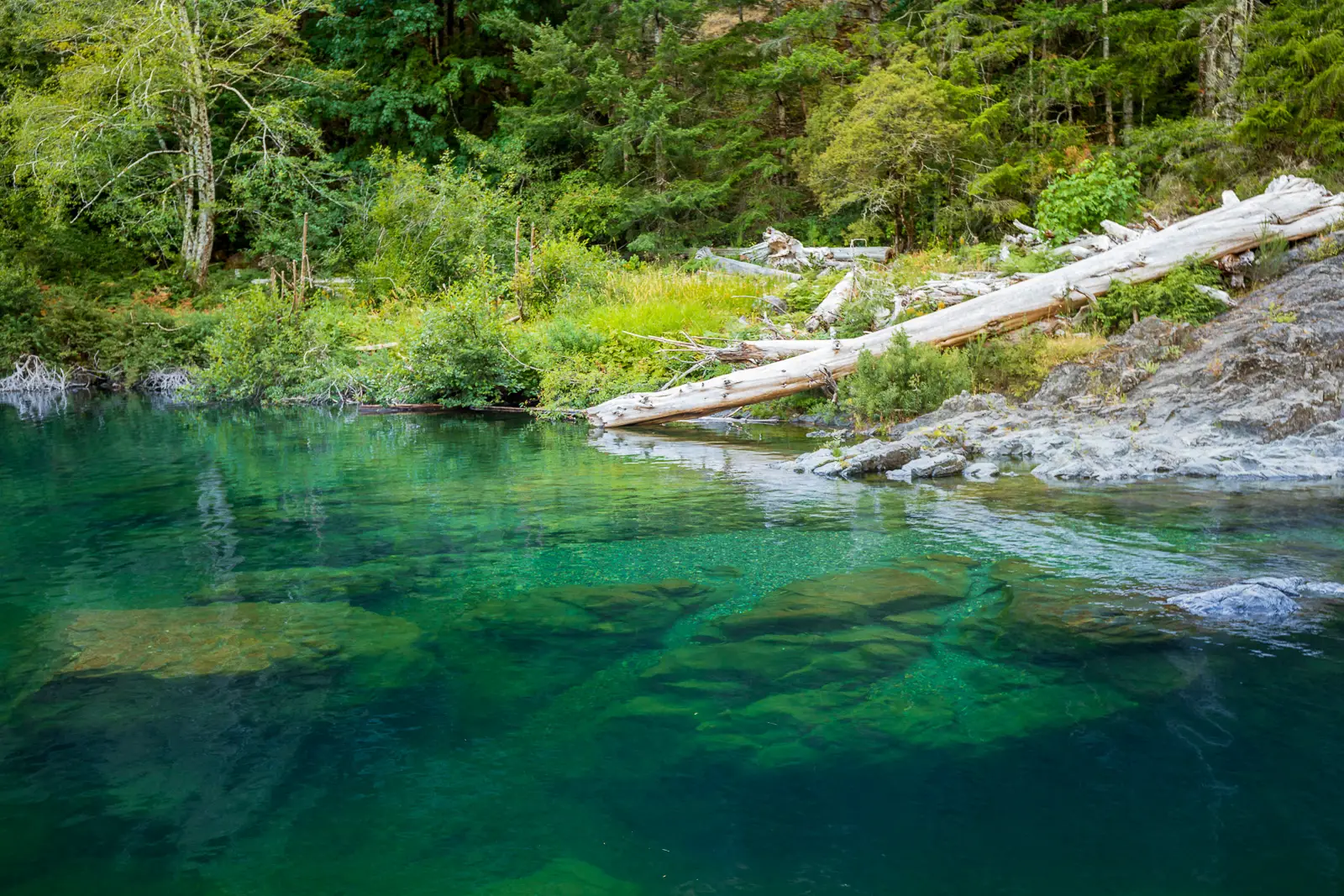
Within Sooke Potholes Regional Park, you’ll find the area’s incredible potholes. These deep pools along the river are great for swimming during the summer months (although the water is pretty chilly).
You’ll find plenty of hang-out spots by the water where you can relax, sunbathe, or jump in for a swim. Even if you don’t want to get wet, the water is a quite stunning color and great for photographs!
If you’re visiting during the winter, make sure you check out Mary Vine Creek Waterfall. One of the best waterfalls near Victoria, this beautiful waterfall is best seen in winter (it often dries up in the summer).
Sooke Potholes Regional Park offers great hiking opportunities year-round. Some of the trails even head into the Sea to Sea Regional Park. There’s also a campground here during the summer if you’re traveling on a budget.
2. Sooke to Port Renfrew
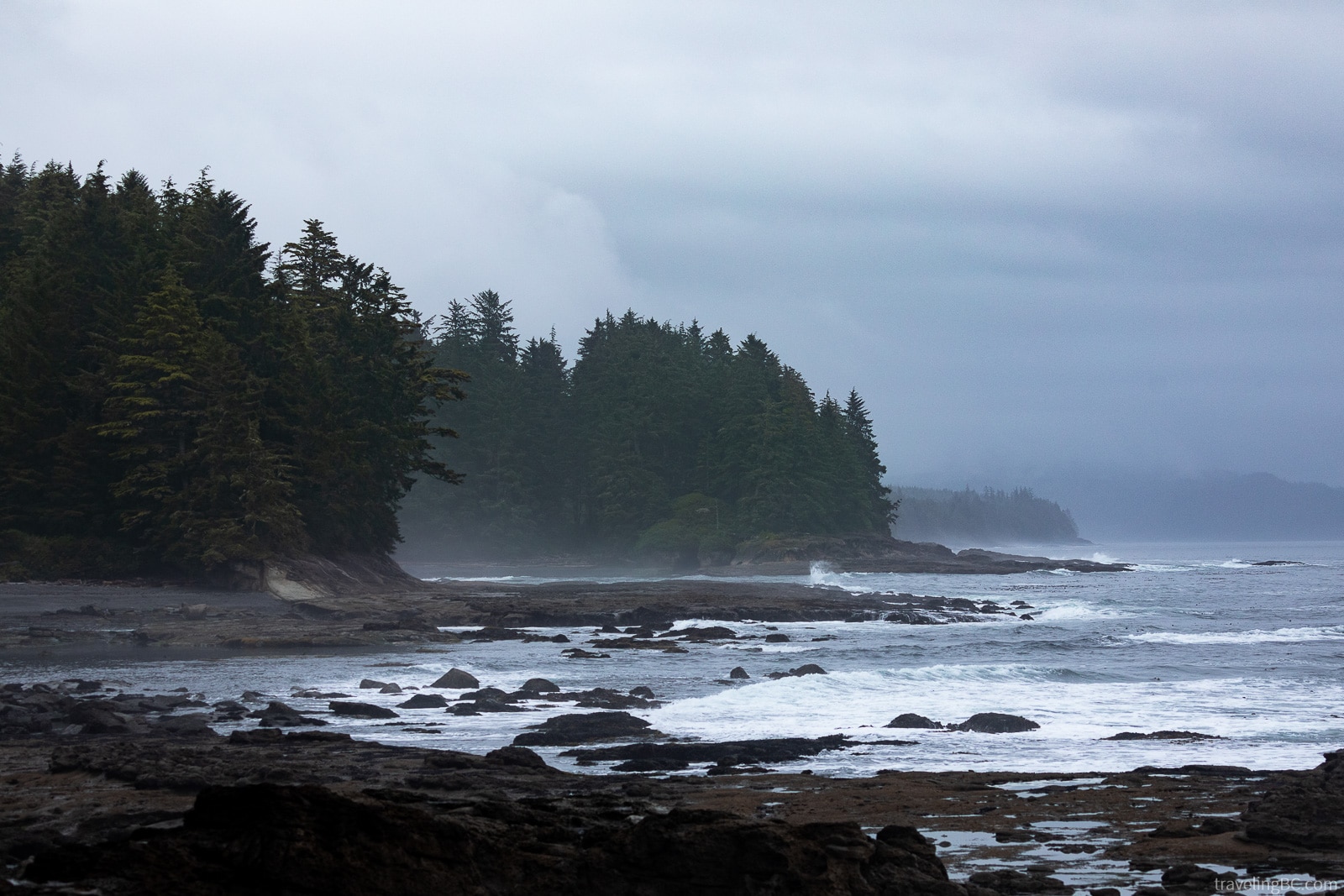
Once you’re done exploring Sooke, the next leg of your journey will take you to Port Renfrew and the wild west coast of Vancouver Island.
From Sooke to Port Renfrew, you’ll be covering a total distance of 71 km. Without stopping, this drive will take around 1.5 hours. But there’s tons to see along this part of the Pacific Marine Circle Route so you’ll want to allow a lot longer than that!
With breathtaking scenery and epic beaches, this part of the drive is probably our favorite section of the Pacific Marine Circle Route. Beautiful beaches, huge trees, and plenty of waterfalls await you on this part of the road trip.
The key thing to mention is that services are very limited along this route until you reach Port Renfrew. For that reason, make sure your vehicle is filled up with gas and that you have an offline map to guide your adventures!
Shirley Delicious
One of the unexpected gems along this stretch of road trip is Shirley Delicious, a highly-rated cafe nestled in the woods of Shirley.
Located just past Sooke, this restaurant is the perfect spot to stop for a bite to eat before starting your big day of exploring. The cafe lives up to its name — the food here is delicious!
Recently, Shirley Delicious was even rated the 13th top restaurant in all of Canada. With tasty food, friendly staff, a great atmosphere, and quirky decor, this cafe will surely charm you!
The only downside? Shirley Delicious gets pretty busy during peak hours. Although there’s often a line, this place is certainly worth the wait.
Sheringham Point Lighthouse
Your next stop around Shirley should be the Sheringham Point Lighthouse. This striking red-and-white National Heritage Lighthouse is a quick stop on your road trip, but is great for a photo or two.
Maintained by the Sheringham Point Lighthouse Preservation Society, the lighthouse is open every day, usually from 9 a.m. to 6 p.m.
Access to the Sheringham Point Lighthouse is via Jennie’s Trail, a short and easy walking trail. There is also another 3.4-km loop trail through the nearby Sheringham Community Park.
Make sure to listen for whales while you’re at the lighthouse. There’s a speaker on the ocean side of the lighthouse, which is connected to an underwater hydrophone. If there are any whales in the area, you’ll be able to hear them!
French Beach Provincial Park
French Beach Provincial Park is a must-visit while driving the Pacific Marine Circle Route. In fact, it’s one of the most easily accessed beaches along this part of the road trip — so it’s definitely worth a stop.
French Beach sits alongside the Strait of Juan de Fuca and offers you a first taste of some of the beautiful beaches that await you on this leg of the road trip. The beach is a mix of sand and rock, and is renowned for its wildlife-watching opportunities.
For those who enjoy camping, French Beach Campground is an ideal spot to set up your tent or trailer. The drive-in campsites are surrounded by moss-covered trees and are just a short walk to the water!
Sandcut Beach
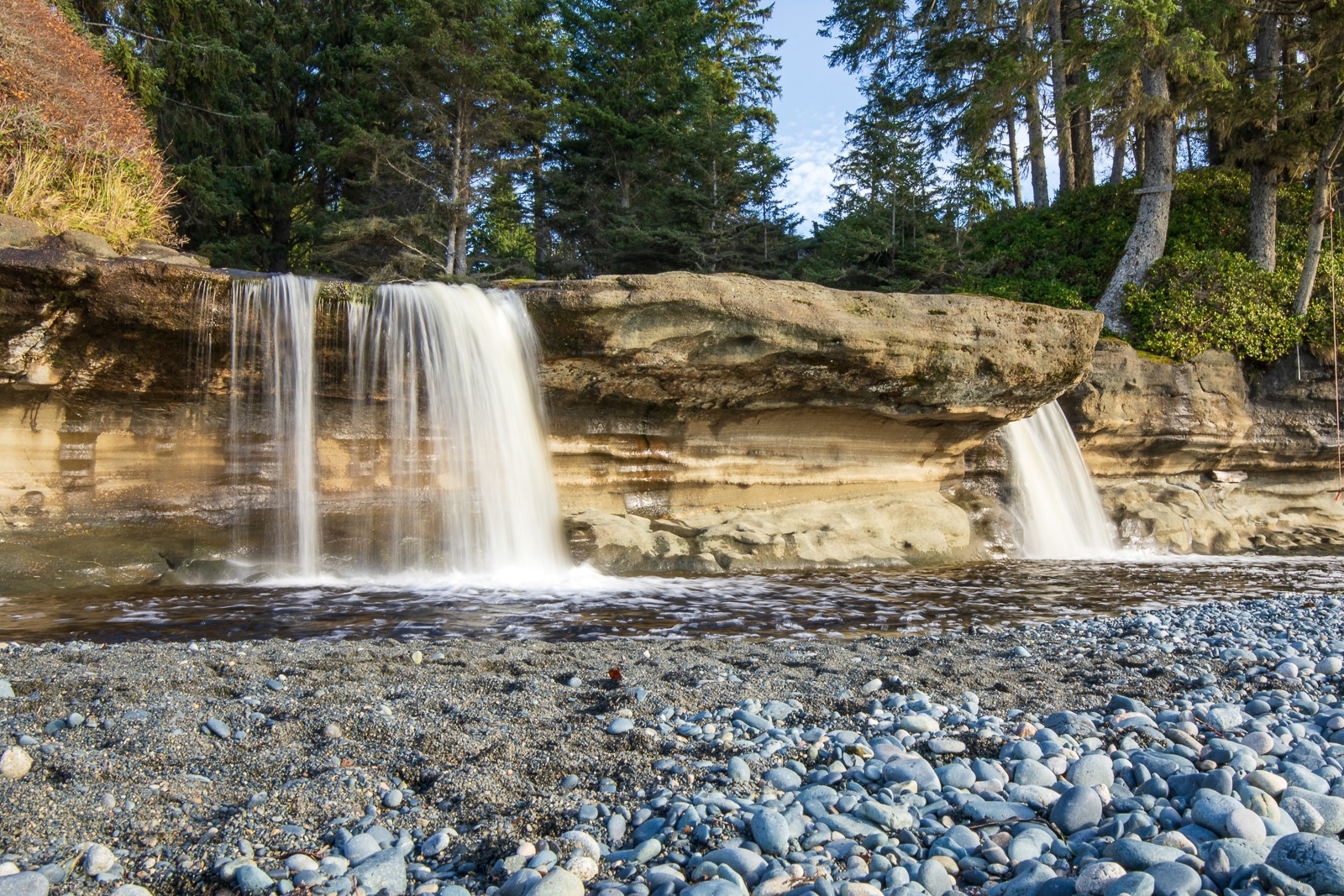
Sandcut Beach is home to one of our favorite waterfalls in Southern Vancouver Island. Cascading right onto the beach, this waterfall is absolutely picturesque.
When combined with a beautiful beach, this is another place that you’ll definitely want to include on your Pacific Marine Circle Route road trip!
To reach the beach you’ll need to walk for around 400-m down through coastal rainforest from the parking lot. Once you reach the shore, you’ll be treated to breathtaking views of the Olympic Peninsula.
Head south to the end of the beach to find the waterfall. Once you’re there, take lots of time to explore the waterfall. If you’re careful, you can climb to the top of the small rock shelf. Sometimes, you can even get behind the waterfall itself!
Sandcut Beach is part of Jordan River Regional Park — but we feel like this beach is important enough to mention separately!
Jordan River
As you continue along Highway 14, you’ll suddenly come across a wide unobstructed view of the ocean — here, you’ll find the rest of Jordan River Regional Park.
If you stopped at Sandcut Beach, then you’ve already explored part of Jordan River. The beach here is pretty similar (but without the waterfall) so you might want to pass it by for some of the next beaches. However, we think it’s a pretty spot to stop and enjoy the ocean views… and if you’re lucky, you can watch some surfers catch the waves!
Jordan River is a popular surfing spot on Vancouver Island (although nothing beats Tofino). In fact, its one of the few good surf spots in all of British Columbia! The swells are especially good during the winter months… but watch out for rocks!
There’s also a campground at Jordan River Regional Park, which offers sea views, toilets, fire rings, and a drinking water station. Spaces are on a first-come first-served basis.
The campground isn’t quite our cup of tea though. It’s right beside the road and offers little privacy, although is an ideal campground for surfers. Otherwise, we recommend staying at French Beach, China Beach, or one of the backcountry beaches in Juan de Fuca Park.
China Beach
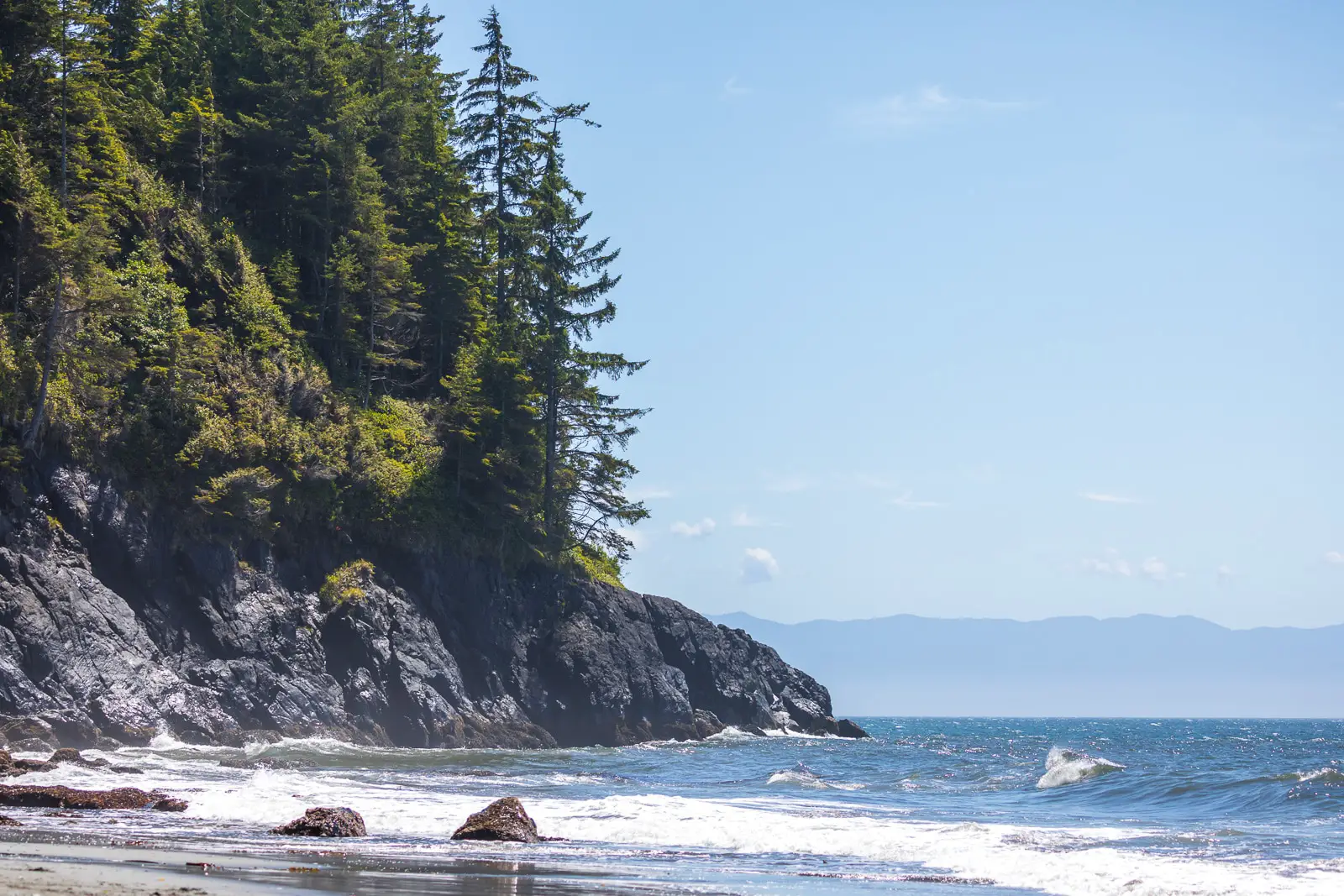
Boasting breathtaking beauty and ample wildlife-watching opportunities, China Beach in Juan de Fuca Provincial Park isn’t a place that you want to miss.
While it is a bit of a walk down to the beach, you’ll be hiking through lush coastal rainforest. Once you arrive at the beach, you’ll be treated to a huge, beautiful beach where you can watch the waves roll in.
Sunbathe on the sandier shores of the beach’s west side, or explore the rocky area along the eastern side of China Beach. Rocky coastline surrounds the beach, with small waterfalls hidden along the shoreline.
You’ll want to park up at the day-use area but there’s also a campground here to the east of this area. The campground is a beautiful place to spend a day or two, if you have the time.
Mystic Beach
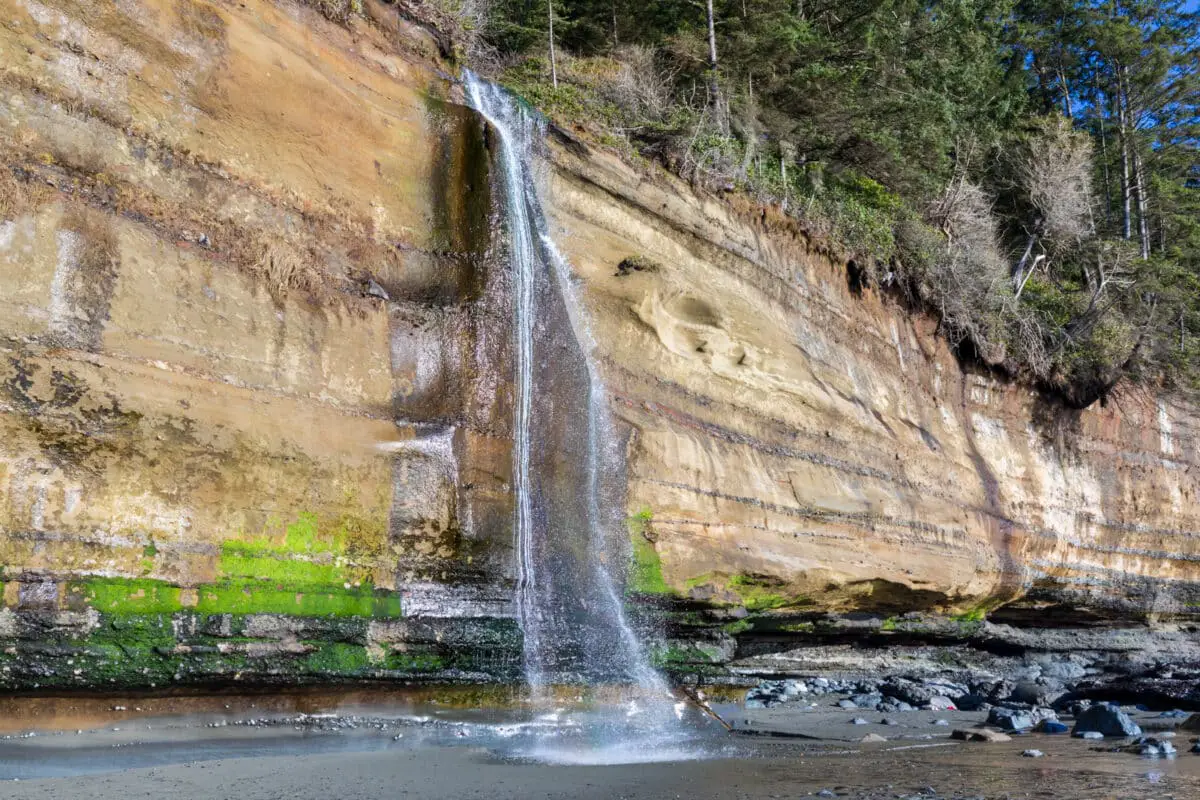
Mystic Beach is considered to be one of the most beautiful beaches in all of Canada, thanks to its lush forest backdrop, coastal cliffs, and stunning beachside waterfall.
The highlight of Mystic Beach is the massive waterfall that cascades down an oceanside cliff, falling right onto the beach. The waterfall is great for cooling off after your hike and makes for some awesome photos!
To reach Mystic Beach, you’ll hike 2-km from the China Beach day-use parking lot. In fact, the trail you’ll be walking along is actually the start of the iconic Juan de Fuca Trail.
Not only is Mystic Beach impressive, but the hike to it offers stunning scenery. There’s even a suspension bridge to cross over Pete Wolfe Creek.
Definitely wear hiking shoes or runners to get to Mystic Beach. We’ve seen lots of people attempt this hike in sandals and we don’t recommend doing that!!
If you’re looking to experience the ‘wild side’, then backcountry camping is available beside the beach. Just make sure you pitch up above the high tide line!
Sombrio Beach
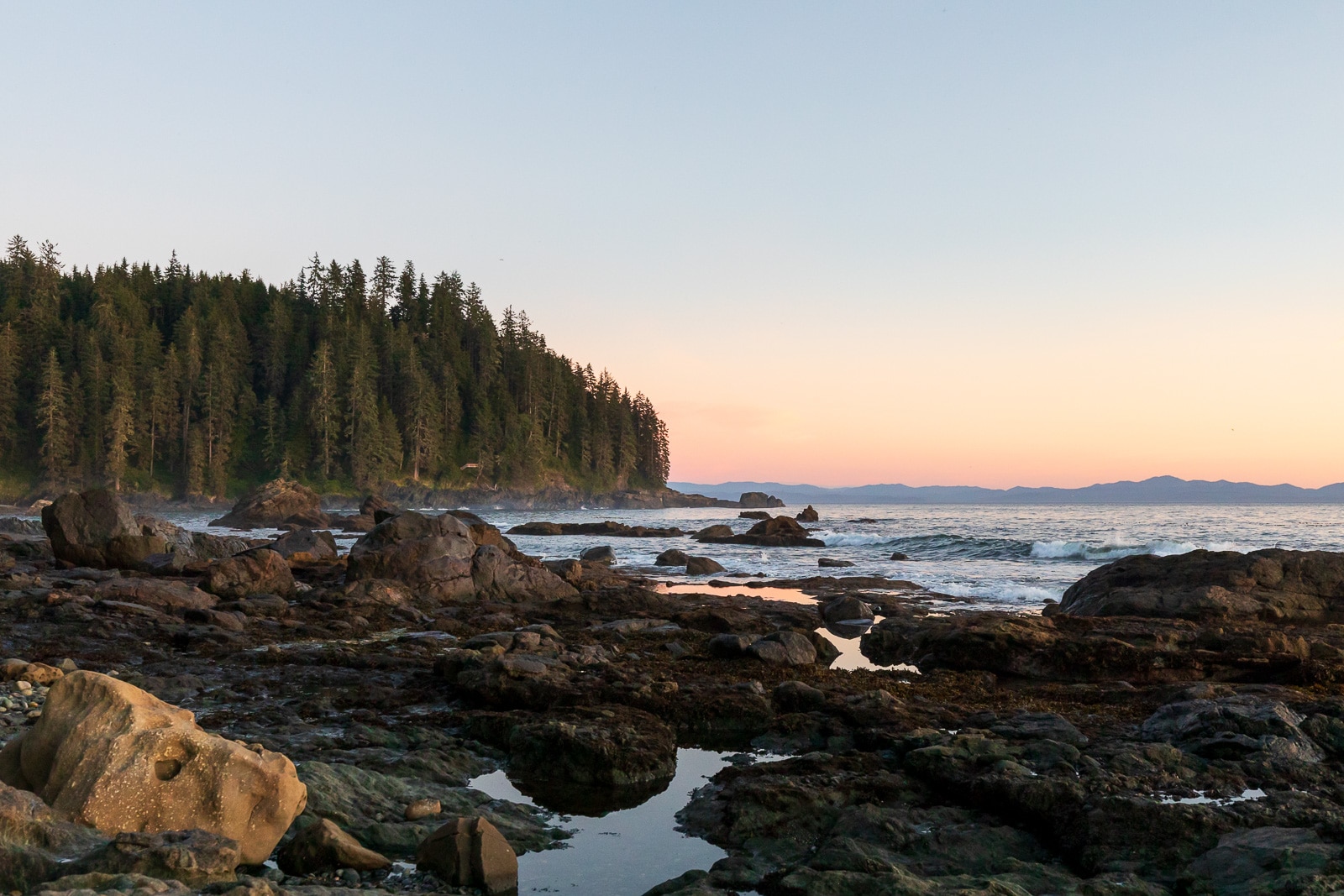
Sombrio Beach is one of the most popular beaches in Juan de Fuca Provincial Park and it’s easy to understand why. This huge rocky beach is framed with tall Douglas fir trees and overlooks the distant Olympic Mountains.
In addition to being jaw-droppingly beautiful, the beach is also easy to access by vehicle. There’s a parking lot and from there, it’s just a short walk down to the shore. Also, Sombrio Beach lies along part of the backcountry Juan de Fuca Trail so it’s popular with hikers and backpackers.
While its not as obvious as Mystic Beach, Sombrio also features a waterfall — but you’ll have to search for it! The hidden waterfall is tucked into the forest, at the end of a small moss-covered canyon.
To find the waterfall, walk to East Sombrio and then follow a small creek up into the forest. While it was once a secret, the waterfall is becoming common knowledge — so if you can’t find it, just ask someone.
Despite being rocky, Sombrio Beach is one of the best surfing spots on Vancouver Island. And like many of the other beaches in Juan de Fuca Provincial Park, you can camp along this beach. Just choose your tent location wisely — stay above the high tide line!
Port Renfrew
While just a small oceanside village, Port Renfrew serves as the gateway to some of Vancouver Island’s best outdoor adventures.
Port Renfrew is home to the southern trailhead of the famous West Coast Trail and the northern Botanical Beach end of the Juan de Fuca Trail. These multi-day trails take backpackers along stunning coastal scenery and through huge forests.
Often called the ‘Tall Tree Capital of Canada’, Port Renfrew is also known for its towering ancient trees in Avatar Grove, the huge Big Lonely Doug, and other surrounding big trees. If you want to see big old-growth trees, this is the place to do so.
Another one of the most popular activities here is whale watching, and this small-group whale-watching tour is a great option. It’s run by Orca Spirit Adventures. You’ll have the chance to see whales, as well as the Carmanah lighthouse and Sea Lion Rock!
While in Port Renfrew, make sure to stop at the Renfrew Pub for a bite to eat and a drink. Also, make sure to check out the dock here too. The village is also a good spot to stay the night after a long day of adventuring, before heading north towards the Cowichan Valley.
Where to Stay in Port Renfrew
Wild Renfrew Seaside Cottages — This is the best place to stay in Port Renfrew, in our opinion. You’ll be staying in cozy, sea-facing cottages. Some of them even feature a fire pit and private hot tub!
West Coast Trail Lodge — There are 20 renovated suites to choose from at West Coast Trail Lodge and many of them offer ocean and forest views.
Botanical Beach and Botany Bay
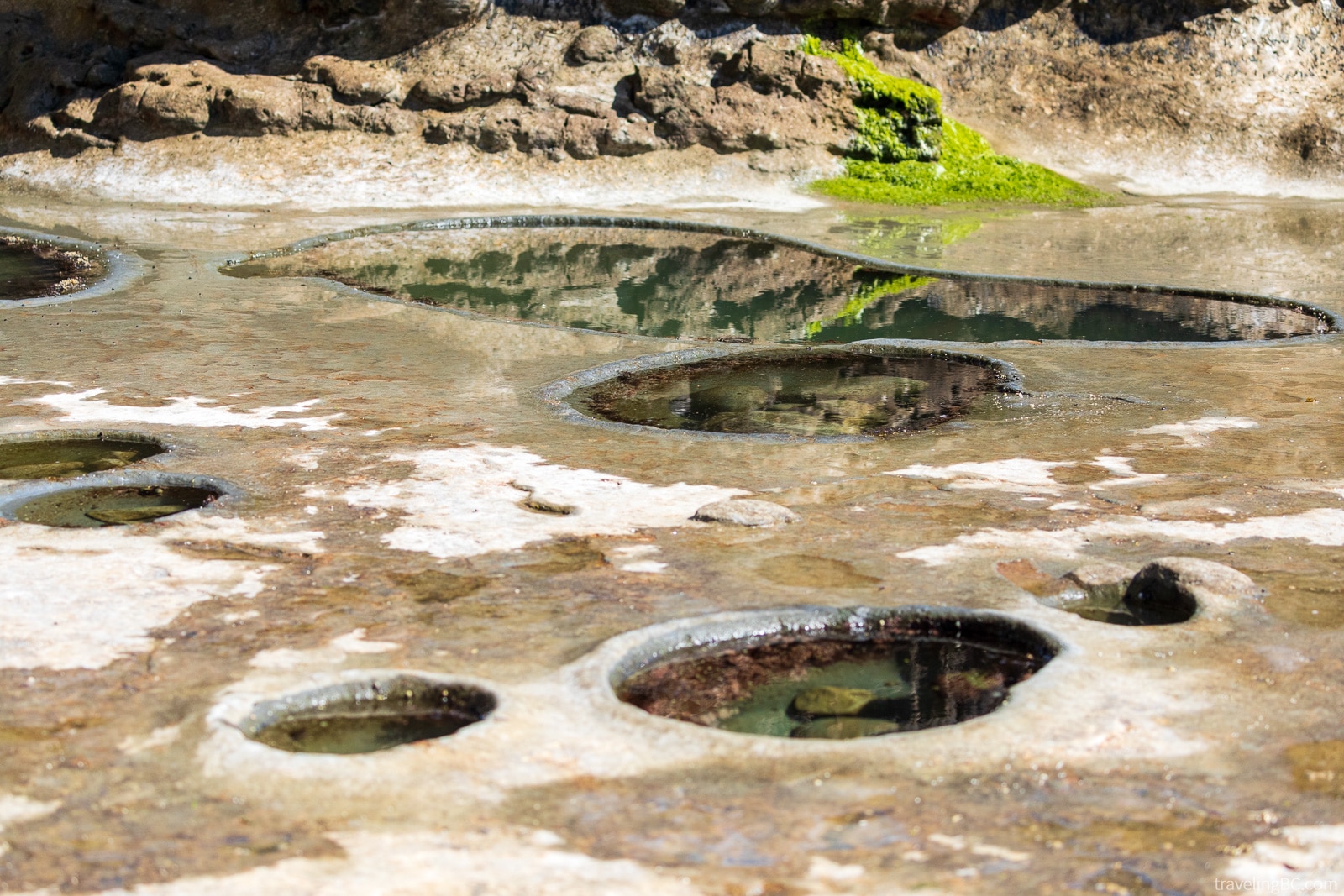
Just a few kilometers from Port Renfrew, you’ll find the beautiful Botanical Beach and Botany Bay. Here, you’ll find some of the best tide pooling on all of Vancouver Island.
One of the highlights of Juan de Fuca Provincial Park, Botanical Beach is renowned for its unique tidal pools carved into the sandstone beach by the ocean. These bowl-shaped tidal pools are filled with a rich diversity of vibrant marine life, from spiky urchins to purple sea stars.
You’ll need to time your visit at low tide to truly experience this ecological wonder. If you visit at high tide, you can still enjoy the breathtaking vistas but the tidal pools will be underwater.
Botany Bay is adjacent to Botanical Beach, so make sure to visit both locations at the same time.
As a heads up, sometimes there’s bear activity in the area, and you can also spot whales off the coast (we’ve seen a gray whale feeding meters offshore).
3. Port Renfrew to Lake Cowichan
The next step of your Pacific Marine Circle Route journey will take you from the rugged coast near Port Renfrew to the peaceful Cowichan Valley, where an entirely different world awaits.
As you leave the picturesque shores behind, your route will take you through lush forests, past beautiful lakes and to quaint villages. The majority of this section will take you inland, along a forest road. However, the views are just as impressive as the coast!
The drive from Port Renfrew to Lake Cowichan is a total distance of 62 km. Without stopping, it’ll take you 1.25 hours — but you’ll want to allow much longer as this is a great area for seeing some of Canada’s oldest and largest trees.
Just be aware that cell service is very spotty along this section, and in some areas, you won’t have any signal at all.
Avatar Grove and Big Lonely Doug
Looking to see some of the best examples of ancient trees on Vancouver Island?
If you’re driving the Pacific Marine Circle Route then you can’t miss out on stopping to see Avatar Grove and Big Lonely Doug.
Avatar Grove is home to many old-growth trees, including Canada’s Gnarliest Cedar tree (a cedar with a huge knotty growth called a burl). There are two forest sections to explore at Avatar Grove: the Upper Grove and the Lower Grove.
Next up is Big Lonely Doug, which is the second-largest tree in Canada. Over 70 meters high, this huge tree sadly stands alone in an empty cutblock within the Gordon River Valley.
Other popular spots for old-growth trees include Harris Creek Sitka Spruce, the San Juan Spruce, and Red Creek Fir.
Most of the trees are accessed down logging roads so drive carefully! For more accessible old-growth trees, check out Cathedral Grove, which is near Port Alberni but not part of the Pacific Marine Circle Route.
Fairy Lake Bonsai Tree
Fairy Lake Bonsai Tree is a popular spot for photography along the Pacific Marine Circle Route.
Located out on Fairy Lake, you’ll see a fallen log with a tiny bonsai-like Douglas fir tree sitting on top of it. Somehow, this stunted tree has managed to survive its rather unique conditions in the middle of the lake and today, it’s a popular photography spot.
The bonsai tree is located near Fairy Lake Recreation Site Campground, and you can actually view it from the road. For a closer look, wander right down to the water’s edge. You won’t need much time to stop here, but it’s a cool place to photograph.
Lake Cowichan
Lake Cowichan is a charming town that’s located on the lake itself, so naturally, you’ll find a variety of water-based activities here. There are plenty of services here too including restaurants, a grocery store, and a gas station!
One of the best places to visit is The Tube Shack which offers one of the best tubing experiences down the Cowichan River. Other popular attractions include Arbutus Park, Gordon Bay Provincial Park, and Little Beach.
While staying here, you can also hike up Bald Mountain, visit Kaatza Station Museum, and walk along Duck Pond Bridge, so there’s a lot that the town offers!
4. Lake Cowichan to Duncan
After Lake Cowichan, you’ll be heading back to the eastern coast of Vancouver Island, with Duncan as your destination.
Your drive parallels the Cowichan River and follows a forest road. The drive from Lake Cowichan to Duncan covers a distance of just 29 km so it’s not far at all.
Without stopping you’re looking at around 30 minutes but we do recommend stopping to check out the Cowichan Valley Trail or Cowichan River Provincial Park along the way. If you’re not the designated driver, then this area is also known for its wineries!
You won’t need to make as many stops along this section of the Pacific Marine Circle Route, but the city of Duncan does have a lot to offer!
Cowichan Valley Trail
The Cowichan Valley Trail is another location that you’ll want to include on your Pacific Marine Circle Route Road Trip. It makes up part of the massive Trans-Canada Trail and is multi-use so it’s suitable for hikers, bikers, and horse-riders.
The Cowichan Valley Trail is also very family-friendly and some people do choose to take strollers with them. Although a great hiking option, it doesn’t get too busy either which is always a bonus.
The trail was once part of a railway so there are a number of historic trestle bridges along the trail. The 70.2 Mile Trestle is the closest to Lake Cowichan and the Holt Creek Trestle is closest to Duncan. However, the Kinsol Trestle near Shawnigan Lake is by far the most impressive and worth a stop.
Along the trail, there are picnic areas so you can always stop off and have something to eat too.
Cowichan River
The Cowichan River is a popular spot to head for the summer months. The river stretches all the way from the Cowichan Estuary in Duncan to Cowichan Lake. Much of the area is protected by the Cowichan River Park.
The river offers a variety of water-based activities including swimming, paddling, and the most popular choice — tubing! There’s nothing better than floating down the river on a hot day.
If you don’t feel like getting wet, you can stroll alongside the river on the 20-km long Cowichan River Footpath. It runs from the Holt Creek Trestle to Skutz Falls. Make sure to check out the 66 Mile Trestle, which offers excellent views of the river below!
Want to stay the night? The Stoltz Pool Campground is nestled in the woods in the bend of the river. You can explore all around the campground on the Stoltz Pool Loop Trail.
This gorgeous river is also a popular spot for fishing. There’s a variety of fish found in these waters, including salmon, steelhead, and trout.
In fact, if you head to Marie Canyon and Skutz Falls during the fall, you’ve got a great chance of watching the salmon spawn. This section of the river closes to fishing during this time of year (October to mid-December).
Duncan
Often referred to as the ‘City of Totems’, Duncan is one of the best places to visit in the area when it comes to culture. Not only is it full of beautifully-carved totem poles, but there are also plenty of attractions to visit.
Some of the most popular spots include the BC Forest Discovery Centre and Cowichan Valley Museum. You can also take a short detour to the Hand of Man Museum if you wish, which is packed full of eccentric items!
While in Duncan, you can hike up Mount Tzouhalem too although it’s quite the challenge.
For those heading to the city on a Saturday, check out the Duncan Farmer’s Market. Here, you’ll find everything from locally-grown produce to handcrafted gifts.
5. Duncan to Victoria
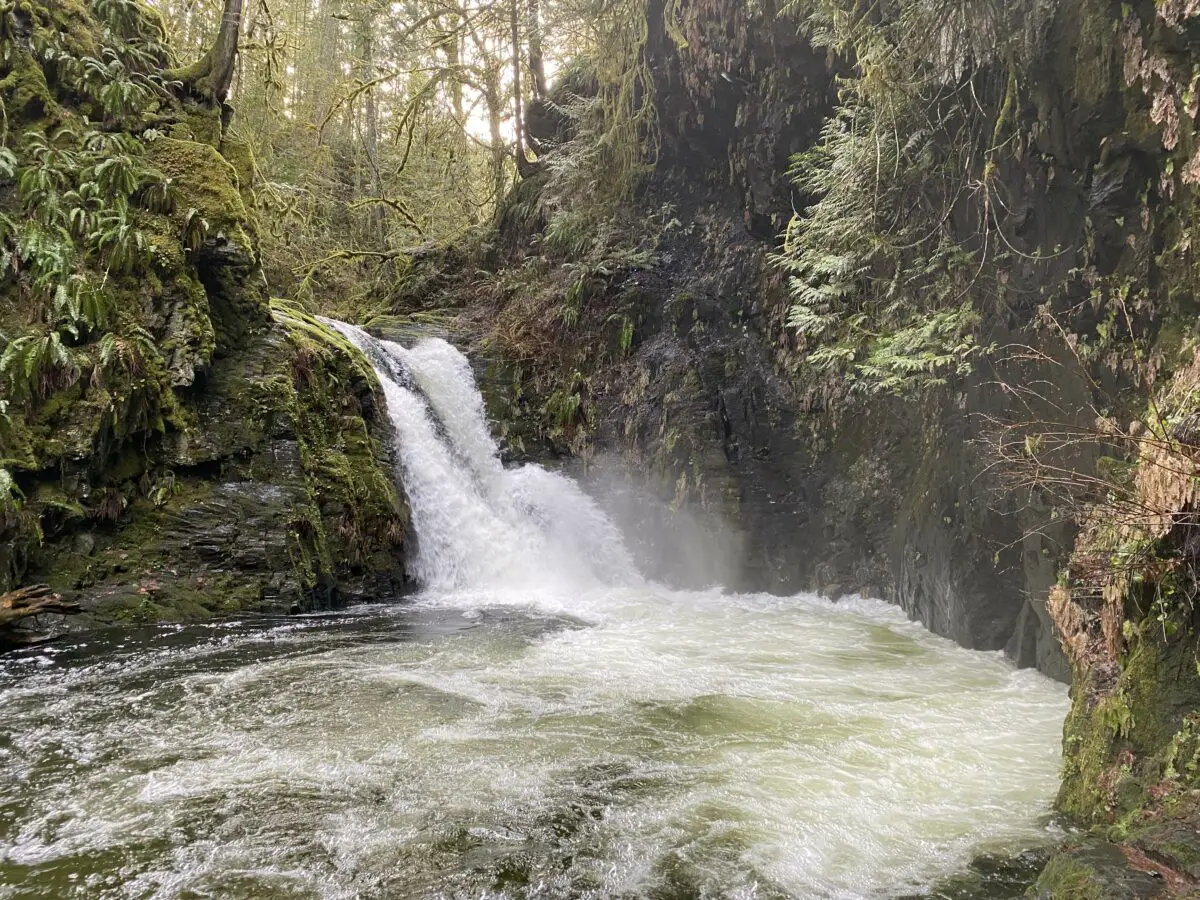
The last section of the Pacific Marine Circle Route road trip takes you from Duncan, back to Victoria. Between the two cities, there’s just 61 km which will take you just under an hour to drive if you don’t make any stops.
This last stretch of your adventure will take you along the Malahat Highway, and there are a few great places to visit before you reach Victoria. Although you won’t spend much time on the road, you don’t want to rush this section.
From the charming town at Cowichan Bay to the beautiful forest of Goldstream Provincial Park, there are a couple of places that you don’t want to miss!
Cowichan Bay
Cowichan Bay is a historic little town that’s located along the waterfront, just south of Duncan. With a laid back atmosphere and slow-paced living, it’s is the perfect spot for relaxing after an action-packed few days.
Spend an afternoon wandering along the main road of Cowichan Bay, stopping to check out art studios or eat at one of the local restaurants.
Or, for a bit more excitement, head out on one of the whale-watching tours that depart from this town too. These 4-hour wildlife cruises have the highest chance of seeing orcas on all of Vancouver Island!
Cowichan Bay is also a great place for spotting sea lions in the fall. All of these large marine mammals love to sunbathe on the docks after feeding on salmon. They are best seen from the public wharf, although you’ll hear them as soon as your in town.
Kinsol Trestle
As you’re driving the Pacific Marine Circle Route, don’t miss out on visiting the historic Kinsol Trestle along the Cowichan Valley Trail.
The Kinsol Trestle is one of the tallest free-standing timber trestle bridges in the entire world. It stands at a total 44 meters, towering high above the Koksilah River. The entire bridge is 187 meters long, making it one of the most spectacular of the eight trestles located along the Cowichan Valley Trail.
You’ll find the trestle just past Shawnigan Lake, which is also a great place to relax and enjoy the views.
It’s an easy 1.2 km walk to the bridge. The pathway is suitable for wheelchair users, strollers, cyclists, and horse riders. While here, make sure you enjoy the lush scenery all around you.
Malahat Skywalk
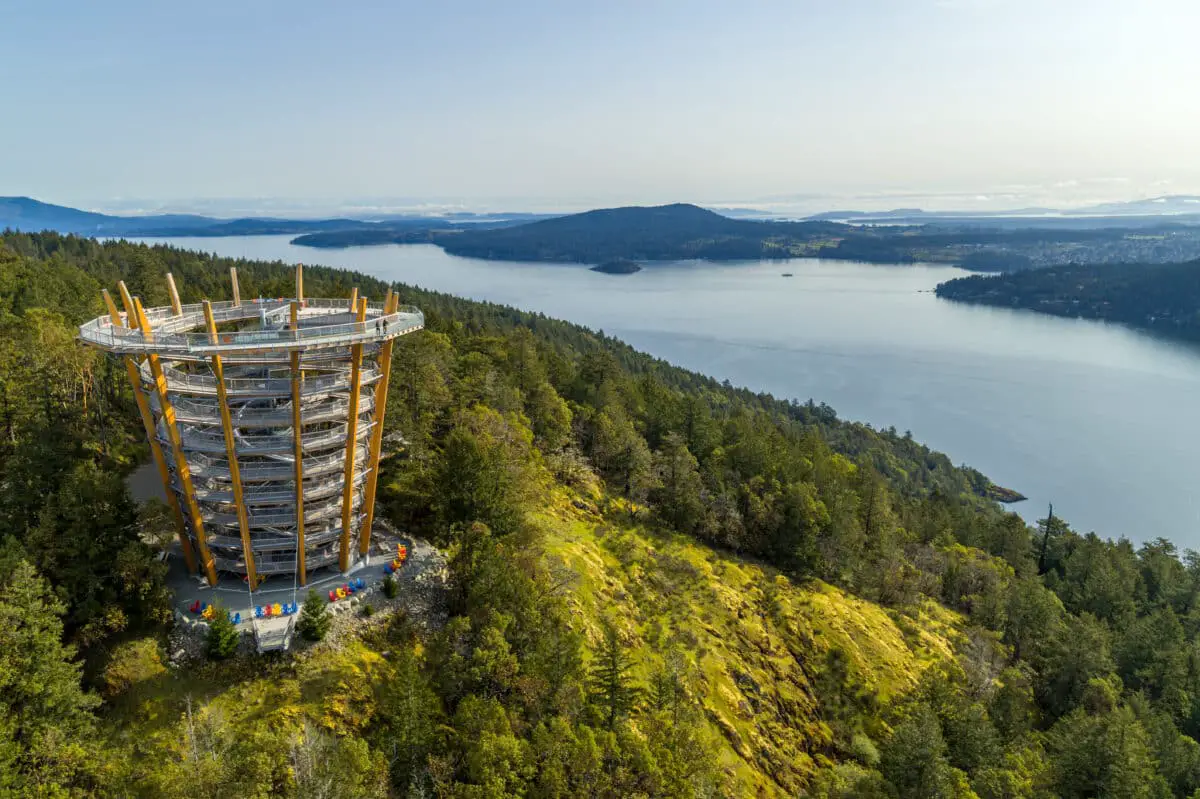
No Pacific Marine Circle Route road trip is complete without visiting the Malahat Skywalk. This observation deck offers jaw-dropping views of the Saanich Inlet, Finlayson Arm, and Mount Baker.
The 32-meter-high lookout is accessible via a 600m tree walk that’s an experience in itself. As you wander along the trail, make sure to take in all the sights and smells, specifically the arbutus trees (whose flowers smell like honey).
Better yet, once you’ve walked to the top of Malahat Skywalk, you can simply slide down the middle of the tower which is super fun!
Goldstream Provincial Park
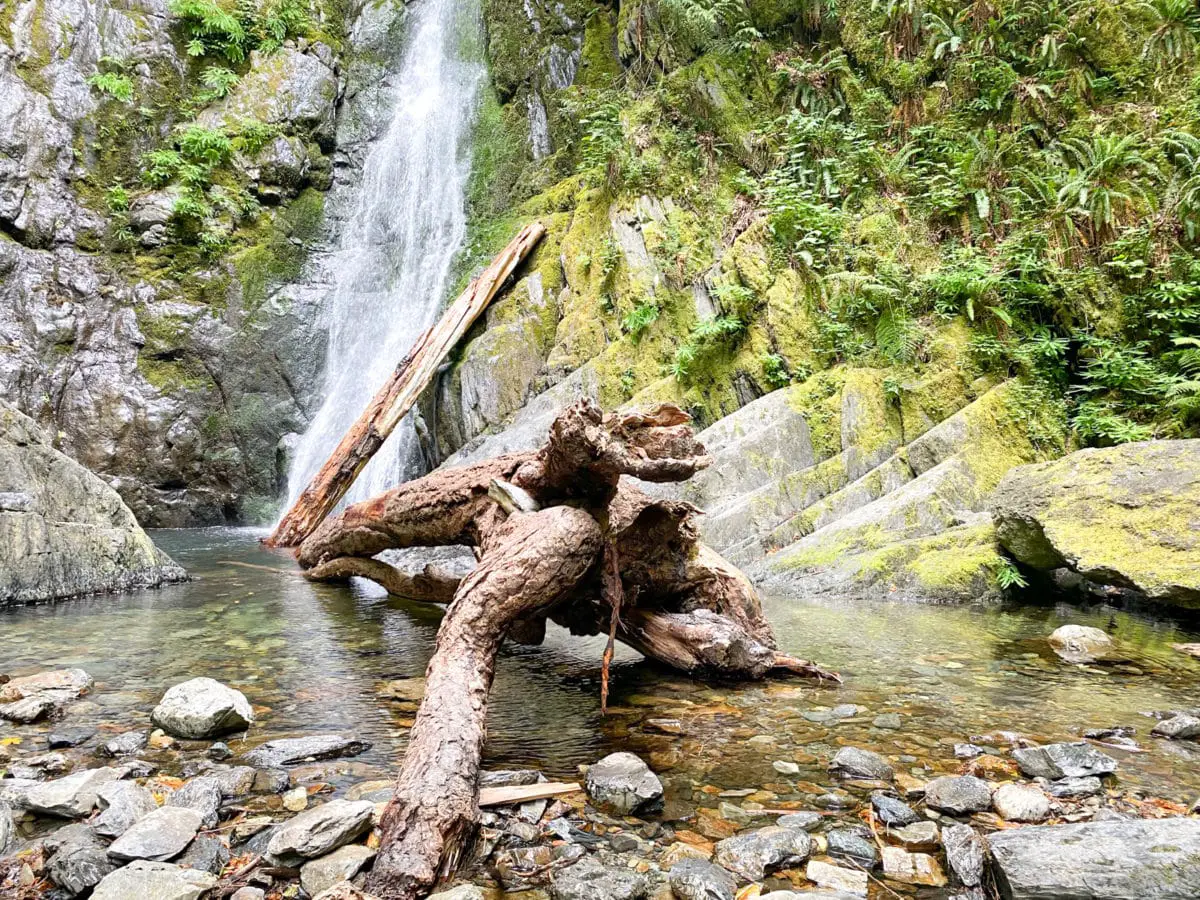
Last but certainly not least on this road trip itinerary is Goldstream Provincial Park. Boasting majestic waterfalls, towering trees, and plenty of wildlife, this incredible place has so much to offer.
One of the most famous waterfalls within this park is Niagara Falls and yes, it shares a name with the waterfall in Ontario!. This waterfall is an impressive 47.5 meters high.
During your time here, you’ll also want to hike up Mount Finlayson. The trail is steep but the views from the top are epic!
If you visit Goldstream Provincial Park during the fall (starting October), you’ll also get to see the salmon run. Make sure you bring binoculars to spot the eagles, too.
Where to Stay on the Pacific Marine Circle Route
You’ll find a variety of accommodation options along the Pacific Marine Circle Route. From charming campgrounds to cozy cabins, there’s something for every budget.
We’d recommend staying in Port Renfrew, more specifically, at the Wild Renfrew Seaside Cottages. Not only will you be in a stunning seafront location, but some of the cabins feature a fire pit or private hot tub.
Alternatively, Sooke is an excellent place to stay along the Pacific Marine Circle Route. If you choose to stay here, SookePoint Ocean Cottage Resort is a fantastic choice as you’ll also benefit from striking sea views!
Another option is to stay somewhere in the Cowichan Valley, like Lake Cowichan. If you’d prefer to stay in this area, then Cowichan River Lodge is a good choice. Nestled in the trees, this wooden lodge has a beautiful location and is quite close to the river.
Top Travel Tips & Resources for Vancouver Island, BC
- Travel Insurance – If you’re travelling internationally, travel insurance is a must for any trip. Being covered by insurance is especially important when you’re going to an adventure-filled place like British Columbia. If you injure yourself while adventuring, you want to have insurance! We recommend using SafetyWing for international travel insurance. They are affordable and have great policies for travellers, digital nomads, and remote workers. Also, SafetyWing provides COVID-19 coverage, which many other insurance companies don’t cover.
- Car Rental – We find the best deal on vehicle rental prices using RentalCars.com. They compare the prices for different car rental companies so you can find the best deals out there!
- Accommodations – We prefer booking all of our hotels, hostels, and other accommodations through Booking.com because they have a flexible cancellation policy. Also, there are lots of different options on their platform, from hotels to vacation homes. Alternatively, Expedia and Hotels.com are good for booking accommodations. For vacation home rentals, VRBO is an excellent choice (they have lower fees than Airbnb, many of the same properties, and are more ethical).
- Flights – You’ll find many good flight deals on Skyscanner or Google Flights. You can book flights through these websites and they’ll help you find the best prices and flight times. If you fly at less popular times (e.g. mid-week or red-eye flights), you can also save some money.
- Tours – Get the most out of your vacation by taking a guided tour! This is a great way to see the city, adventure to exciting new locations, and learn about the local culture. Viator or GetYourGuide are great options for booking tours.
